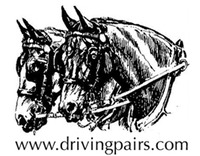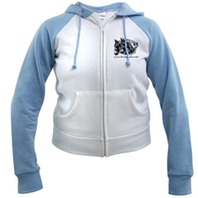by Hardy Zantke
So you want to start driving a pair, huh? And you think you can do it on your own? You know the saying: Green & green makes black and blue? So save your hide, your animals and your equipment and get some pair driving instructions from a qualified teacher, ok?
But I know, there are always some who need to do it on their own, and since we can’t change that, then let me at least offer a few, perhaps helpful hints from between my blinders. Since this is the Pairs List I will only mention pair specific items here, as I assume that you’ll have single driving experience and know how to handle driving horses and how to drive single. If you don’t, then get that experience first.
If you can’t get your hands on a reliable pair, then start out with two reliable single horses (or ponies) which you can drive safely single with trust and confidence. If you don’t have two of those, there is really no point for you considering driving whatever you have in a pair. So get to that point first. (Note: experienced pair drivers don’t need that, they can start a young horse with a schoolmaster in the pair, but this is not written for them!)
Then make sure the two singles get along with each other. They don’t need to be the greatest buddies, but they should tolerate each other without kicking or biting. Get them used to each other including bumping into each other. You can do that by riding them together with a partner, but close together. Or you can ground drive them with a partner, each ground driving one with single reins and ground driving them close to each other. All at the walk is fine. Riding, you can trot as well, or even canter, but make sure, we don’t have any kicking at each other at the canter. So if you canter together, start them further apart before coming closer together. All this is good preparation to make sure they tolerate each other working closely together, which they will need to do next to the pole, in a pair.
Next get a set of pair reins and a good book explaining the function of pair reins. There are good explanations available, so I don’t need to do that here. I recommend "The Art of Driving by Max Pape" or "The Principles of Driving by the German National Equestrian Federation". Both are available through the ADS (www.americandrivingsociety.org). If you study "The Art of Driving" then you are in royal company, because this is what Prince Philip used to learn to drive as stated in his newest book. They didn‘t even have an English version then. He did it from the German version! So if he could do that, you surely can study the English version now.
As a very quick version of the pair rein function: You need to know four basic items:
- Horses too close together and/or heads turned towards each other: You need to lengthen the coupling reins = coupling rein buckles need to go one or more holes forward.
(Note: Heads turned together mostly is not due to too short coupling reins, but due to wrong pair driving - which you will learn in Driving 102 below. But coupling reins also need to be the proper length.)
- Horses too far apart and/or heads turned away from each other: The opposite from above: You need to shorten the coupling reins = coupling rein buckles need to go one or more holes backwards.
- One horse more eager than the other, or having a shorter neck than the other: He needs to be taken back by bringing the coupling rein buckle on his back FORWARD (which shortens his draft rein!) and the coupling rein buckle on the back of his partner BACKWARDS (which shortens his coupling rein).
- Important! On all the above adjustments, you always must adjust BOTH coupling buckles by the SAME number of holes (provided you started out even on both reins). Never change only one, as then the horses can’t move straight.
Do more reading in the driving books.
Next step: You can ground drive the two horses now at the walk using the pair reins. Also use a connecting strap (or rope) between the two collars, but don’t tie them together too closely. You just want this as some help that they don’t get too far apart when starting out uneven. Have a helper on each head to help them start out together and then walk them around the ring.
When all went well then, as the next step, you can hitch them to the pair carriage. If the carriage has an evener, make sure to set that fixed, or tie it so that it will be fixed. We do not want to start horses with an evener as they will start out uneven and the evener will not help, but only add to the problem.
Have helpers again at the heads to start them out even. If they do start uneven - and they will - trust you - do NOT hold them back in trying to correct that, but do drive FORWARD and it will work itself out.
Note: The beginners’ mistake is to hold them back to try again to start out even. That is wrong. Here is why: You ask them to go forward. One was quicker than the other to follow your command. Mrs. Eager did it right away, and Mr. Slowpoke is still thinking about it. The cure is to top Mr. Slowpoke with your whip and get him going. If you were to hold them back now, Mrs. Eager would be punished for going forward and would get totally confused. “Why are you holding me back now? Didn’t you just ask us to go forward? But that’s not enough.” Since Mrs. Eager is following your commands she would now stop again, when you hold back, just at about the very moment that Mr. Slowpoke got the idea to go forward. So you get that bad see-saw effect, which all beginner pair drivers have when they hitch their horses the first time, It only gets worse if you hold back. So the answer is, as always in driving: FORWARD and it will work itself out. Mr. Slowpoke will finally wake up and follow Mrs. Eager, as he is dragged along, or as you hopefully helped him waking up with your whip. Note: Not with your voice, as that would only upset Mrs. Eager more. Second note: Drive with blinders, as with open bridles your whip coming would also upset Mrs. Eager more. The above is also the explanation, why you don’t want an evener at this stage of the game. Mrs. Eager goes forward first, and at moment she does, Mr. Slowpoke, just thinking about starting as well, gets hit in the chest by his collar as his traces are coming tight through the evener, which he might take as a signal to stop instead of going forward. So Mr. Slowpoke could get confused getting different messages. You said to go, but when he wanted to go, the slap on his chest said to stop. Without the evener, or with the evener tied up (or inactivated), this problem won’t occur.
So once you start going FORWARD, great! You got it. Drive at the walk for a while, straight as much as you can and get after the lazier one of the two, as each pair has lazy one. Be careful when you have to make turns and don’t turn too sharp as the inside horse will rub his hind leg against the pole and might think of kicking if that pole hits him too much. So make careful wide turns and watch that inside horse’s hind leg.
When all goes well at the walk and is calm, you can also carefully try it at a calm trot. Bring them back to the walk for the turns, unless the turns are real wide.
Halt, unhitch and put them away and congratulate yourself on the first successful pair drive. Have a beer (wine is acceptable too) and join the ranks of the pair drivers.
Then move on to Pair Driving 102.
Happy pair driving.
Hardy



